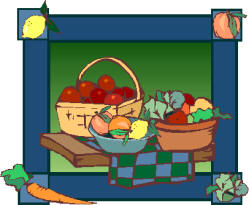13 Ways To Eat More Fruits and Vegetables

1. Try at least one new vegetable or fruit each week. To enliven meals, switch from the old, familiar green beans, apples and bananas to okra, winter squash, papaya and kiwi.
2.
Eat more
“meal” salads.
Use a large salad as the base, but throw in meat “condiments” —several ounces of
cooked chicken, turkey, tuna or some low-fat cheese and/or legumes. Add warm
bread, and you’ve got a complete meal.
See
Dinner Recipes for
examples. For very simple ideas, see BOB'S SIMPLEST SALAD MIXTURES and use
Bob's
Everything But The Kitchen Sink Salad as a base for scrumptious meals.
3. Put fruit in your vegetables. Add sliced or chopped apples, pears, grapes, melon, kiwi and orange sections to tossed spinach and cabbage salads. You can even combine cooked vegetables with fruit. Try the “Fruit & Vegetable Salad”. Serve cooked yams, with Carrot-Apple Salad and Black Bean and Corn Salad (see Dinner Recipes section).
4. Take advantage of ready-made bag salads. These are great when you’re in a rush or feeling tired. Look for fresh ingredients, and add a low-fat or fat-free dressing. Experiment with some of the darker greens, like Romaine, kale, and leaf lettuce—they’re tastier and more nutritious.
5. Have at least one fruit serving with each meal. It’s easy. For instance, have a banana or strawberries on cereal, a piece of fresh fruit with your lunch and/or as a snack and a fruit serving with dinner. (If you don’t feel like cooking a vegetable or making a salad, slice up some cantaloupe or honeydew melon.) Look over ideas for Stoveless Meals in the Essential Skills area. Also visit ideas for delicious breakfasts and lunches.
6. If you’re in the dessert habit, try substituting fruit, served in a creative way, in place of at least three deserts a week. For instance, try an apple baked with some cinnamon and a few raisins, a banana with a small amount of reduced-fat peanut butter, or “Baked Bananas” (see recipes), a bowl of fresh, juicy mixed berries, or a big serving of fruit on top of a small serving of frozen yogurt or angel food cake. (To save on unwanted calories, avoid fruit canned or frozen in heavy syrup or with added sugar.) See also Nutritious and Yummy Snack ideas.
7. Experiment with nonfat flavorings. Sprinkle nutmeg and lemon juice on spinach or broccoli, dill week and Dijon-style mustard on green beans or carrots, and basil on tomatoes.
8. Mix your vegetables. For example, combine corn and beans, zucchini and onions, red potato and carrot slivers, eggplant and tomatoes, cucumbers and onions. Frozen mixtures without sauce are fine too. Try “Italian Salad” or “Italian Marinated Vegetables” or “Steamed Marinated Vegetables”. Discover Essential Skills #6 Planning and Preparing Delicious Recipes.
9. Eat more vegetable-rich main dishes. For instance, try “Eggplant Parmesan” or “Zucchini Pizza” (see dinner recipes).
10. Combine vegetables with tasty broths and juices. Green beans cooked in chicken broth, summer squash in tomato juice, and carrots or beets in fruit juice are flavorful and need no added fat.
11. Have at least one vegetable at lunchtime. Take along ready-to-eat carrots, cucumbers and celery, or red pepper slices with fat-free salad dressing. If there’s a refrigerator at work, keep these items on hand.
12. Be creative with low-fat potato toppings. Try salsa, nonfat cheese, and nonfat sour cream with chives, fat-free butter spray and a few bacon bits, fat-free salad dressings, low-fat chili or low-fat cottage cheese with dill weed.
13. Try roasting or grilling vegetables. Roasted vegetables taste heartier and more flavorful than steamed or boiled ones, and they are easy to prepare. Coat chunks of peppers, zucchini, summer squash, onions, eggplant or firm tomatoes with a light coating of vegetable spray or marinate them in a low-fat dressing, and grill or bake at 400° F oven for about 15 minutes, turning occasionally.
Anne shares many terrific ideas of "the masters of weight control". She gives 21 days of ideas for breakfasts, lunches, dinners, and snacks, as well as, appetizers, main dishes, salad dressings, and relishes and more. Adapted from “Eating Thin For Life” Food Secrets & Recipes from People Who Have Lost Weight & Kept It Off by Anne M. Fletcher, M.S., R.D., Chapters Publishing LTD., (2003). Information in blue is added.
See Ann's web site for a description of her other WONDERFUL BOOKS:
Additional Terrific Ideas For Enjoying Fruits & Vegetables
- Why Fruits and Vegetables Are SO Important to Your Health? The CDC has updated its fruits and vegetables Web site to reflect the new Fruits & Veggies-More Matters TM campaign, which takes the place of the 5 A Day program. Visit the new http://www.fruitsandveggiesmorematters.org/ Web site to get tools and information to help you eat more fruits and vegetables each day!
- Sumptuous Nutrition Discoveries, Food Facts, Nutrition Quizzes, Tips, Resources, and More: www.dolenutrition.com
- Tips to Help You Eat Vegetables on Super Tracker: http://www.choosemyplate.gov/supertracker-tools.html
- It's The Berries! Discover the top 20 Antioxidant-rich Foods! http://lancaster.unl.edu/feature/guess1_16.htm
Fruits and Veggies Help You Manage Weight.pdf
|
|
|||||
|
|
|
|
Introducing the next generation of 5 A Day! The CDC has updated its fruits and vegetables Web site to reflect the new Fruits & Veggies-More Matters TM campaign, which takes the place of the 5 A Day program. Visit the new http://www.fruitsandveggiesmorematters.org/ Web site to get tools and information to help you eat more fruits and vegetables each day!
|
||
